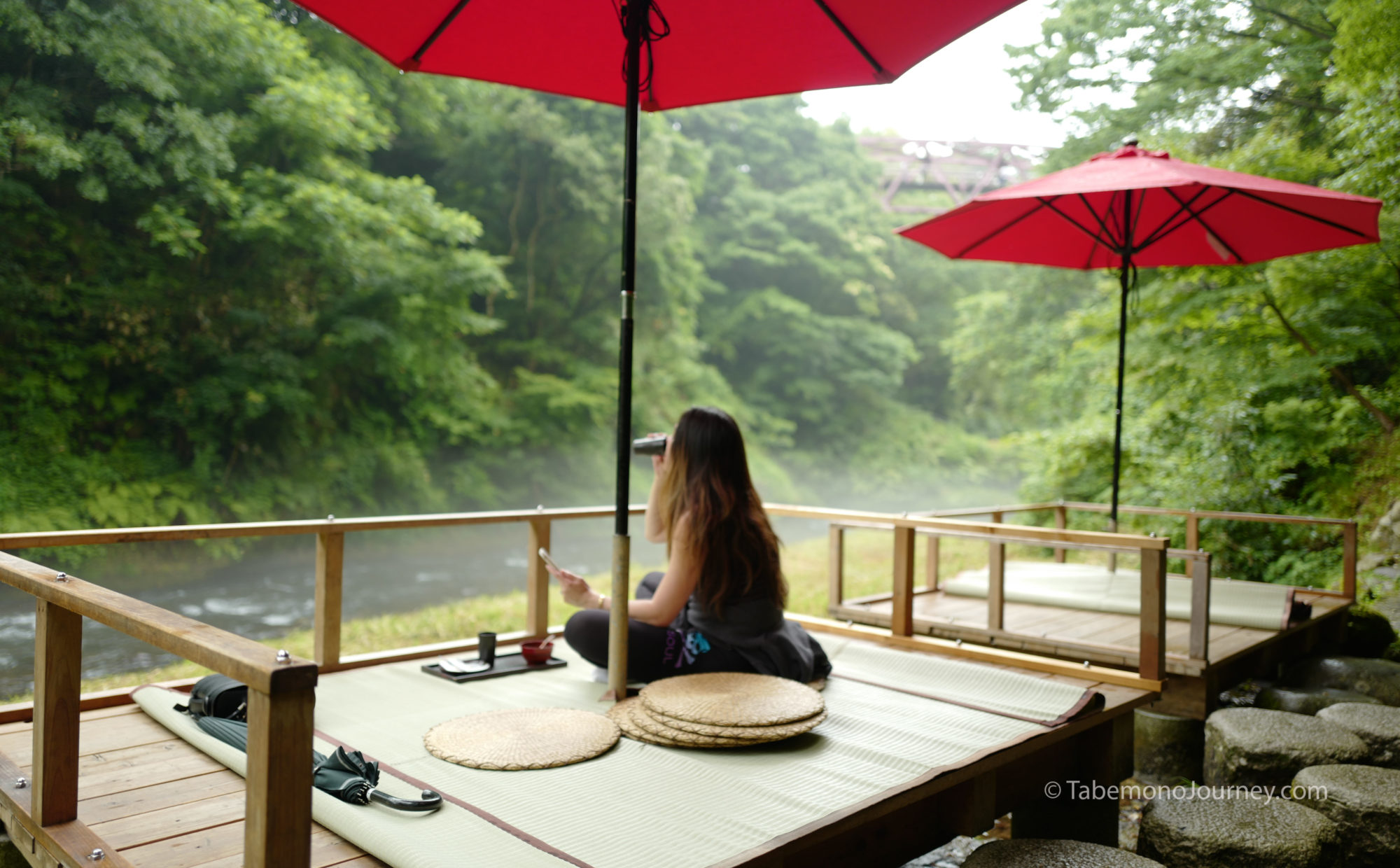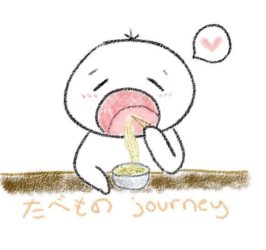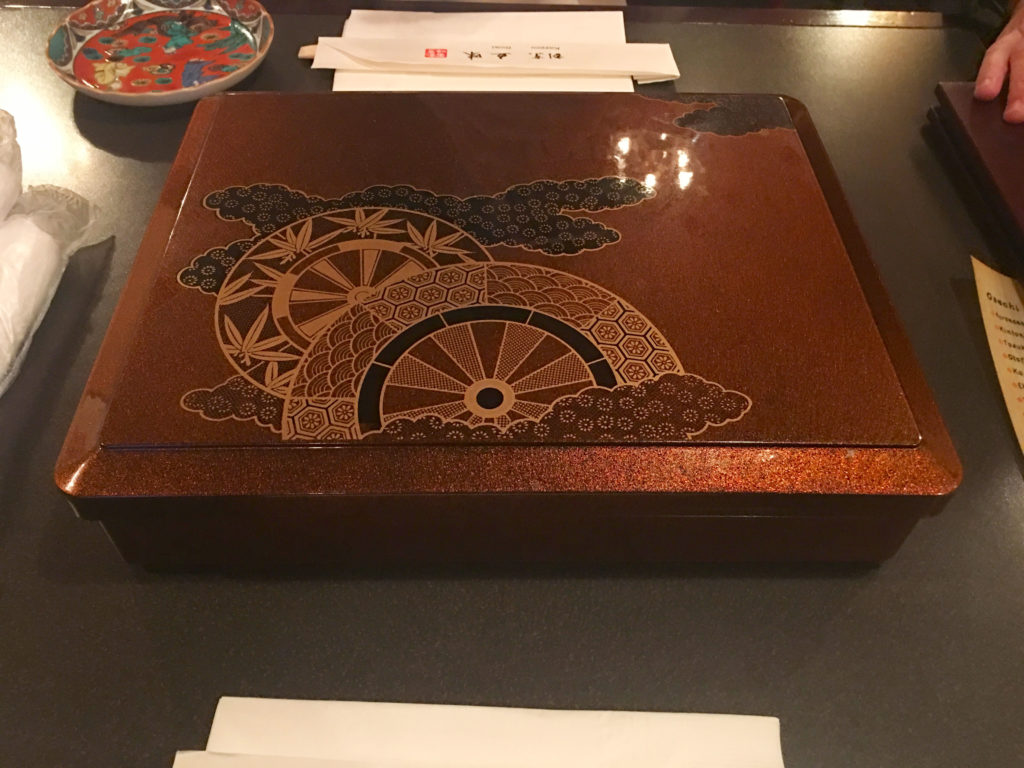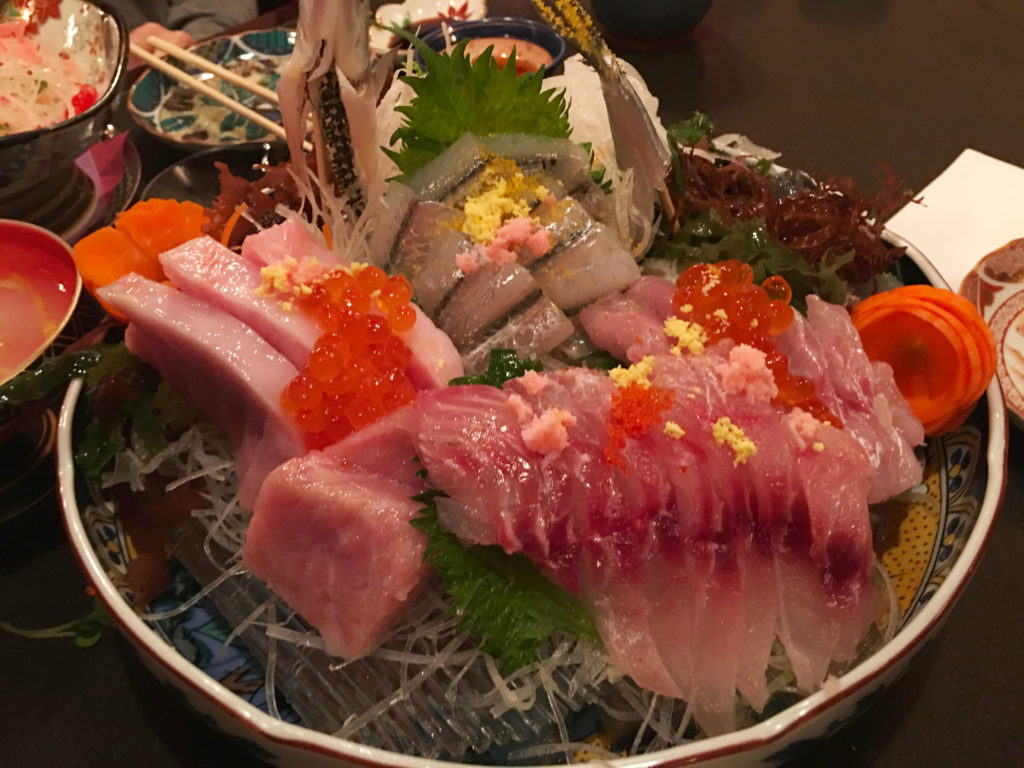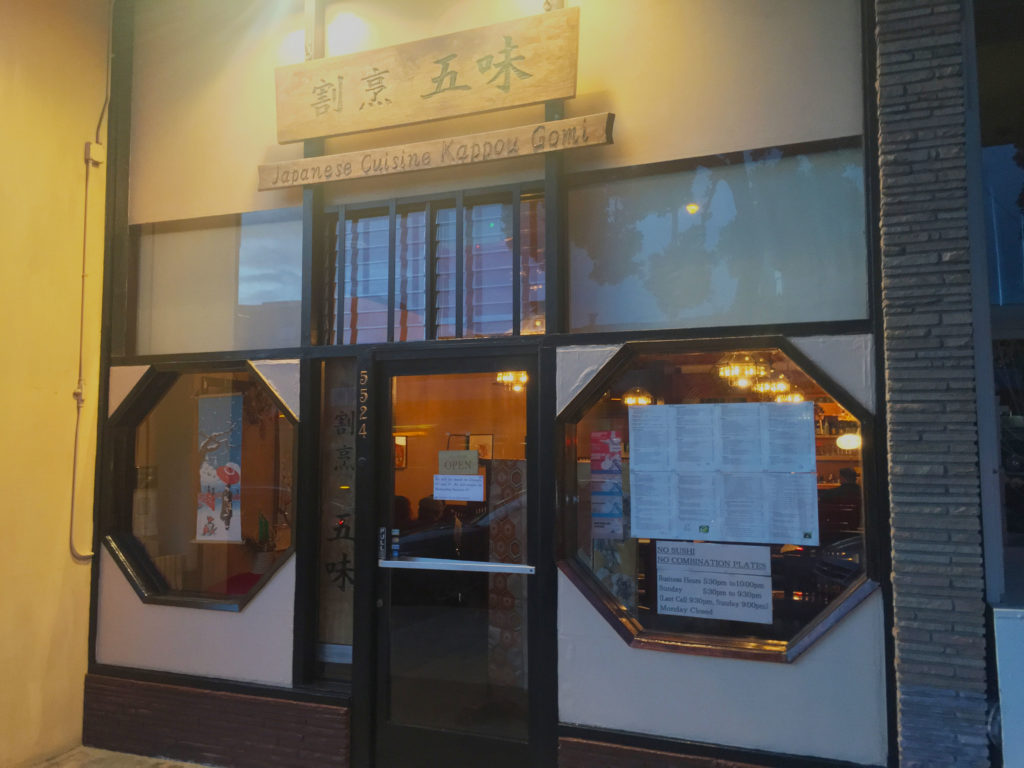Update 10/21/2017 – Unfortunately after 8 years, Kappou Gomi closes its doors as the Chef and Owner, Gomi-san is retiring. Will miss this place for both the food and the hospitality provided by the Gomi-san and his wife Harumi. If you like to continue reading on what is Osechi, continue reading, but otherwise know that this style of cooking cannot be found elsewhere that I know of in the SF Bay Area.
Kappou Gomi is my favorite Japanese Restaurant in San Francisco as they have very authentic Japanese food and is comparable to what we experienced in Japan. In here you will not find sushi, bento box, or izakaya dishes but instead the restaurant focuses on Kappo/Kappou style cuisine, which is a traditional style of Japanese cooking. It is a great option as a family style restaurant where you can share lots of different dishes. The highlights of the restuarant will range from seasonal seafood, fried dishes, and simmered soup dishes, but we usually love to order from the daily specials menu which will have some seasonal Japanese ingredients and seasonal dishes.
One tradition we have done for the past five years is to have our New Years dinner here. This is because Kappou Gomi will have their version of osechi ryori. Osechi ryori are traditional Japanese food served usually only during New Year’s Eve and New Year’s Day. They are usually served in lacquer boxes called jubako. Harumi, who is the wife of the chef and owner and runs the dining area, once told us that her husband would spend at least a week preparing the various dishes.
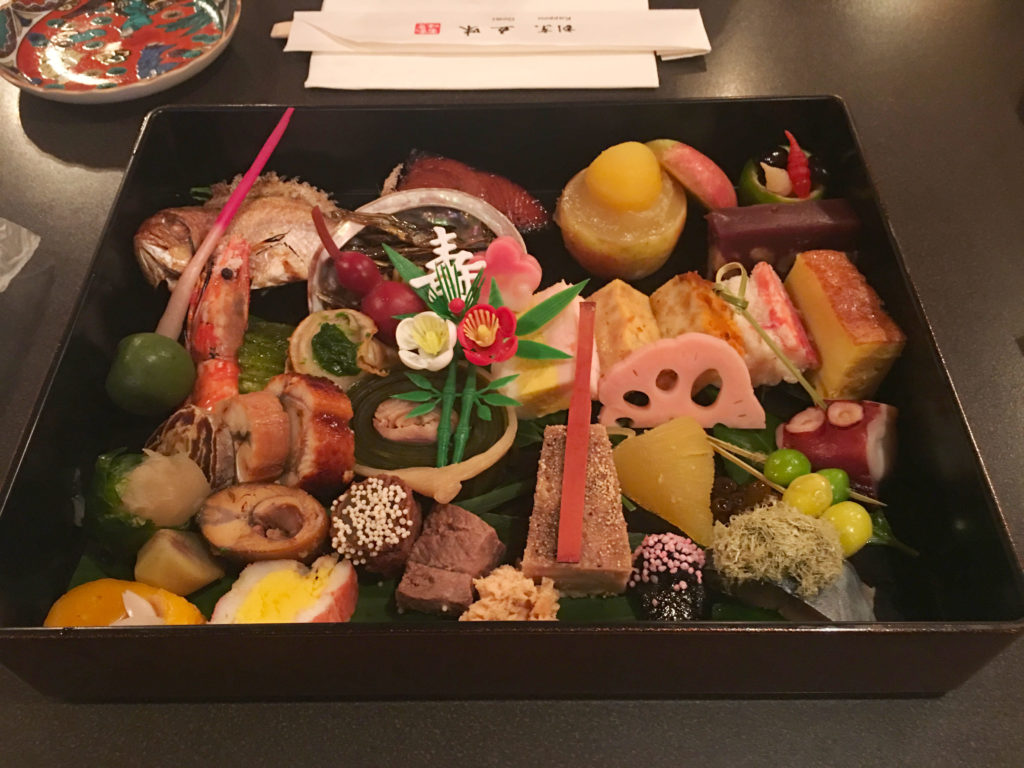 Inside the box, you will find many tiny bites that range from simple to complex preparations. There will be key ingredients that have special meaning in celebrating the coming year. Several examples include:
Inside the box, you will find many tiny bites that range from simple to complex preparations. There will be key ingredients that have special meaning in celebrating the coming year. Several examples include:
-
- nishiki tamago (egg dish)would be for wealth and good fortune
- kuromame (black soy beans) symbolizes being healthy
- kazunoko (herring roe) symbolizes a wish for fertility
- kamaboko (broiled fish cake) have a festive celebration meaning
- konbu (seaweed) is associated with joy
- tazukuri (soy sauce dried sardines) symbolizes an abundant field harvest
- ebi (shrimp) represents a wish for longevity
- and so on
This year in particular, our osechi box was twice as big as in the past and the number of items much larger than we’ve had than the past.
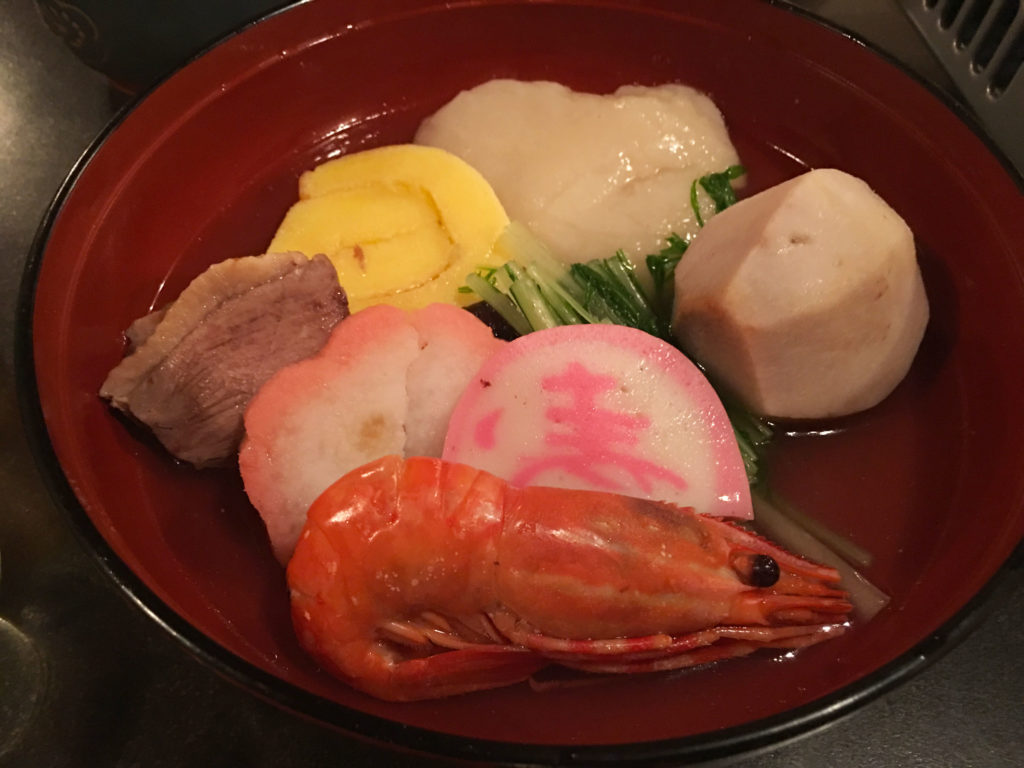 Additionally, Kappou Gomi will serve ozoni for the occasion, which is a Japanese soup containing mochi rice cakes and paired with other ingredients such as shrimp, fish cake, duck, taro, and mountain yam. Ozoni is again a Japanese item eaten on New Year’s Day.
Additionally, Kappou Gomi will serve ozoni for the occasion, which is a Japanese soup containing mochi rice cakes and paired with other ingredients such as shrimp, fish cake, duck, taro, and mountain yam. Ozoni is again a Japanese item eaten on New Year’s Day.
Along with the osechi and ozoni, we would usually order some of the daily specials and wrap up with some of our favorites. Some of the items on the specials menu that caught our eye included the following:
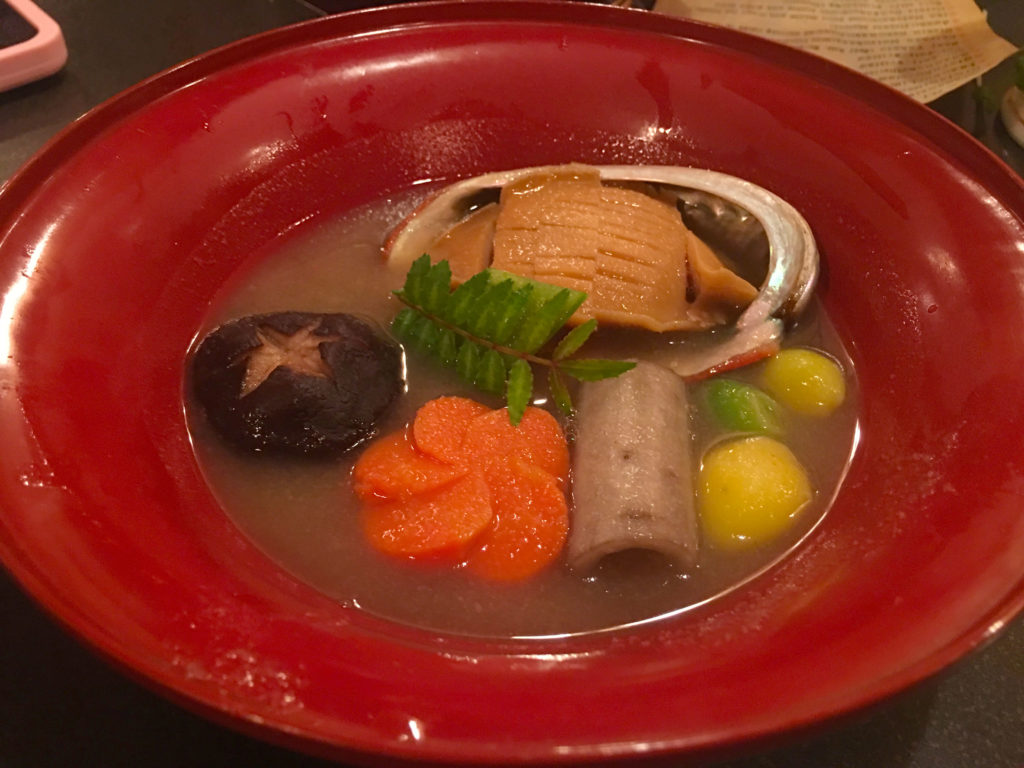 Awabi nimono – simmered abalone in dashi, soy, sake, and mirin. Kyoto cuisine specializes in simmered dishes in broth and dashi. We always order at least one such simmered dish.
Awabi nimono – simmered abalone in dashi, soy, sake, and mirin. Kyoto cuisine specializes in simmered dishes in broth and dashi. We always order at least one such simmered dish.
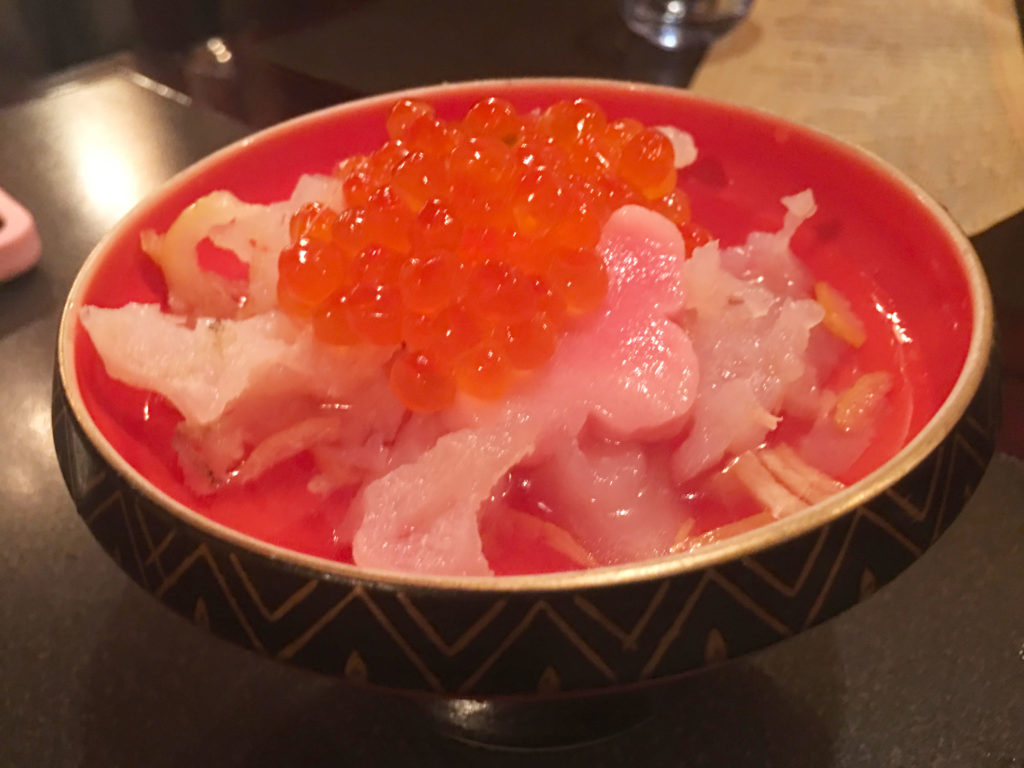 This is salmon cartilage in a vinegar sauce. The cartilage is carefully pulled from the head and other parts of the salmon and then cooked and cooled. It’s more for texture than taste, but great with sake.
This is salmon cartilage in a vinegar sauce. The cartilage is carefully pulled from the head and other parts of the salmon and then cooked and cooled. It’s more for texture than taste, but great with sake.
We ordered some of the sashimi specials which had fish flown from Japan. It changes weekly, but today we had blue fin toro, saiyori (half beak), isaki, and medai.
Along with the specials, Kappou Gomi has many exotic eats that even few people in Japan would eat. I have not seen these dishes outside of Japan, except at Kappou Gomi.
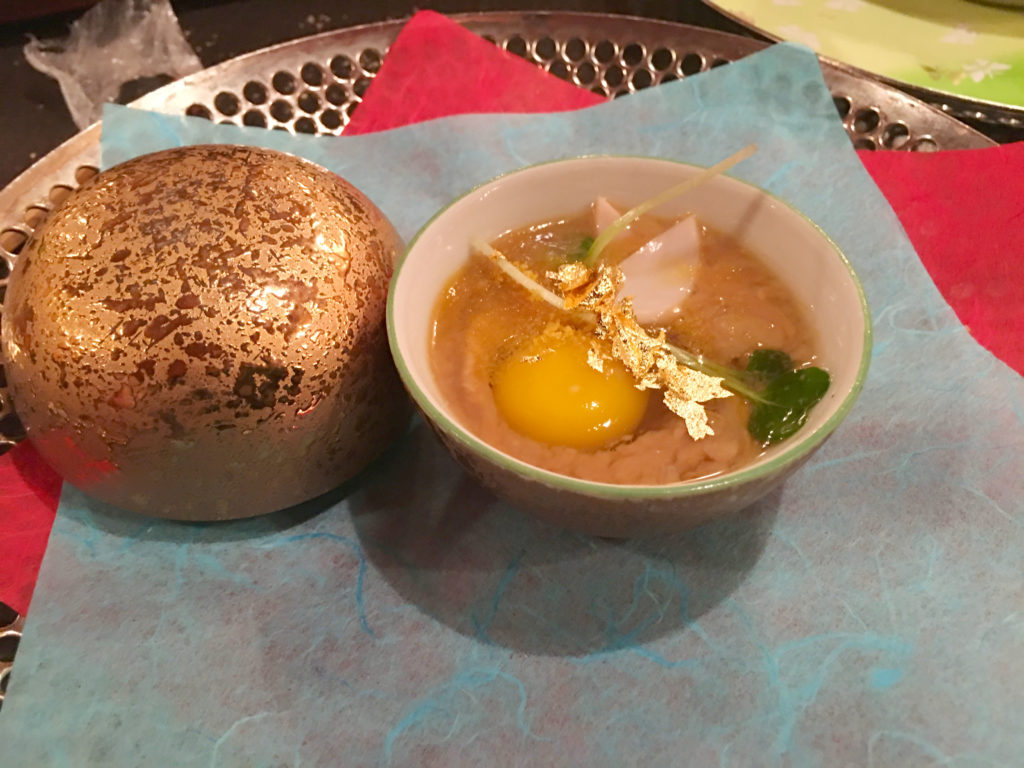 This is konowata, which is the innards of a sea cucumber. Its texture is very slimy texture and parts that are chewy. It taste briny with a sweet sea ocean taste. Stronger than uni, but my wife and I love this item. I recall ordering konowata at Haruka Sushi in Tokyo and they were surprised I knew what it was and even more surprised I would eat it as even the locals rarely eat this. Here, a quail egg is added to make it richer in taste.
This is konowata, which is the innards of a sea cucumber. Its texture is very slimy texture and parts that are chewy. It taste briny with a sweet sea ocean taste. Stronger than uni, but my wife and I love this item. I recall ordering konowata at Haruka Sushi in Tokyo and they were surprised I knew what it was and even more surprised I would eat it as even the locals rarely eat this. Here, a quail egg is added to make it richer in taste.
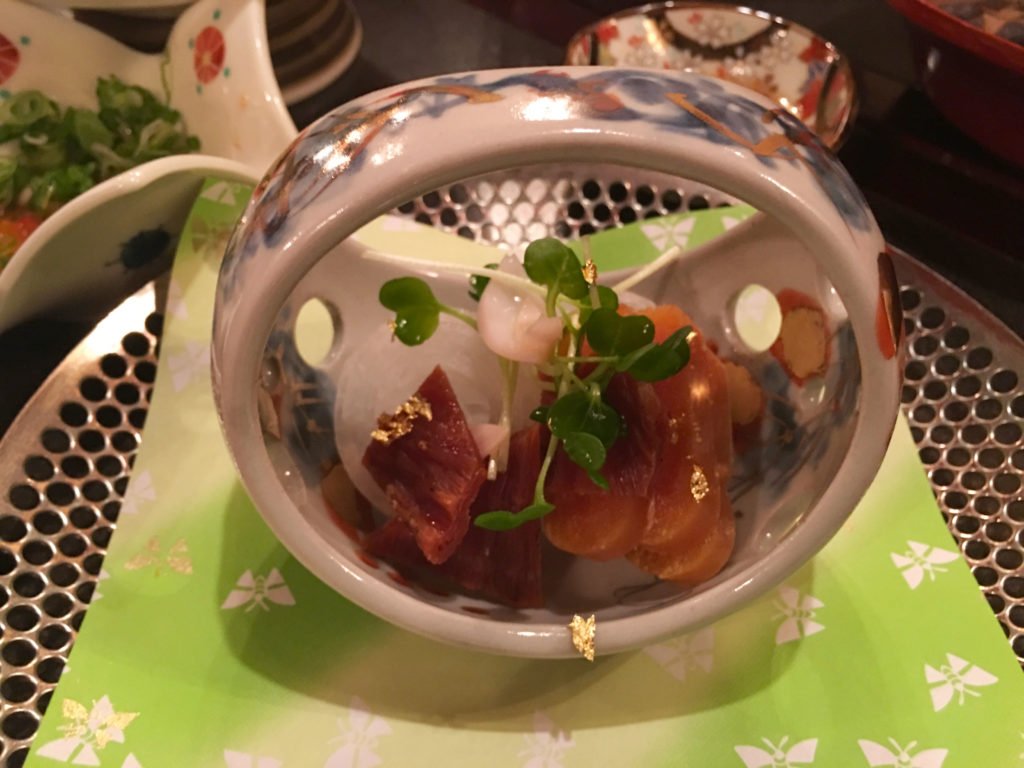 The are two items here, one that is brown and one that’s orange with some radish in the background. The brownish item is actually kuchiko, which is sea cucumber eggs. It is quite expensive to make as each strand of sea cucumber egg is collected and then made into a sheet and then dried. The other item is karasumi, which is mullet roe. They both go well with sake as they have a briny and salty taste, yet still has that umami of the sea.
The are two items here, one that is brown and one that’s orange with some radish in the background. The brownish item is actually kuchiko, which is sea cucumber eggs. It is quite expensive to make as each strand of sea cucumber egg is collected and then made into a sheet and then dried. The other item is karasumi, which is mullet roe. They both go well with sake as they have a briny and salty taste, yet still has that umami of the sea.
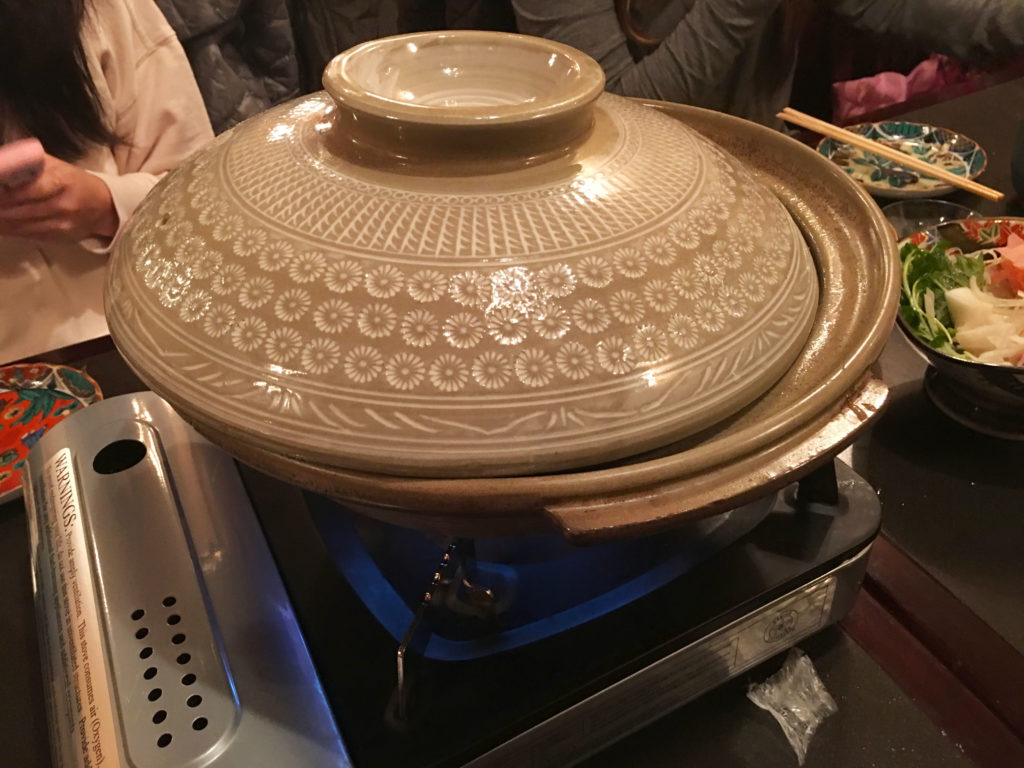 We usually then wrap up with a shabu shabu nabe dish. They have different types ranging from kurobuta (black pork), wagyu (beef), to sea food such as crab and different dish. Each would have a different broth to compliment the meat item. The pot would be brought out in front of us with the lid on so that the broth can come to a boil faster.
We usually then wrap up with a shabu shabu nabe dish. They have different types ranging from kurobuta (black pork), wagyu (beef), to sea food such as crab and different dish. Each would have a different broth to compliment the meat item. The pot would be brought out in front of us with the lid on so that the broth can come to a boil faster.
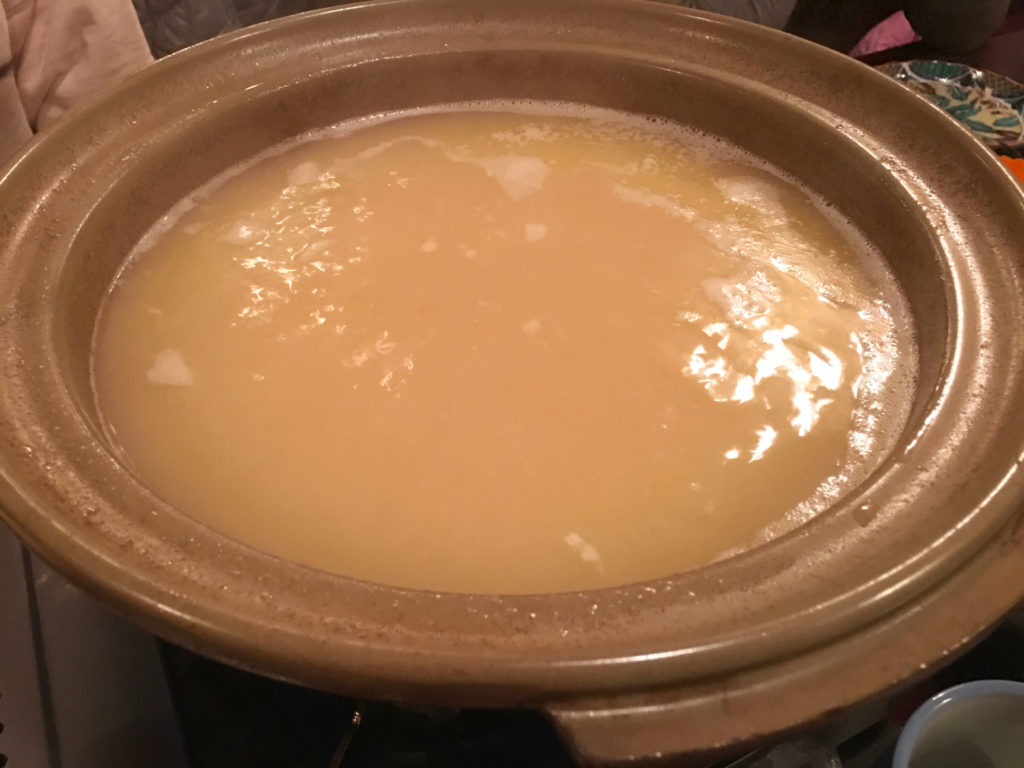 We like the ishikari broth with the salmon the most. It is a miso butter dashi base and it was something we grew to appreciate more after our trip to Hokkaido, where this broth originated from.
We like the ishikari broth with the salmon the most. It is a miso butter dashi base and it was something we grew to appreciate more after our trip to Hokkaido, where this broth originated from.
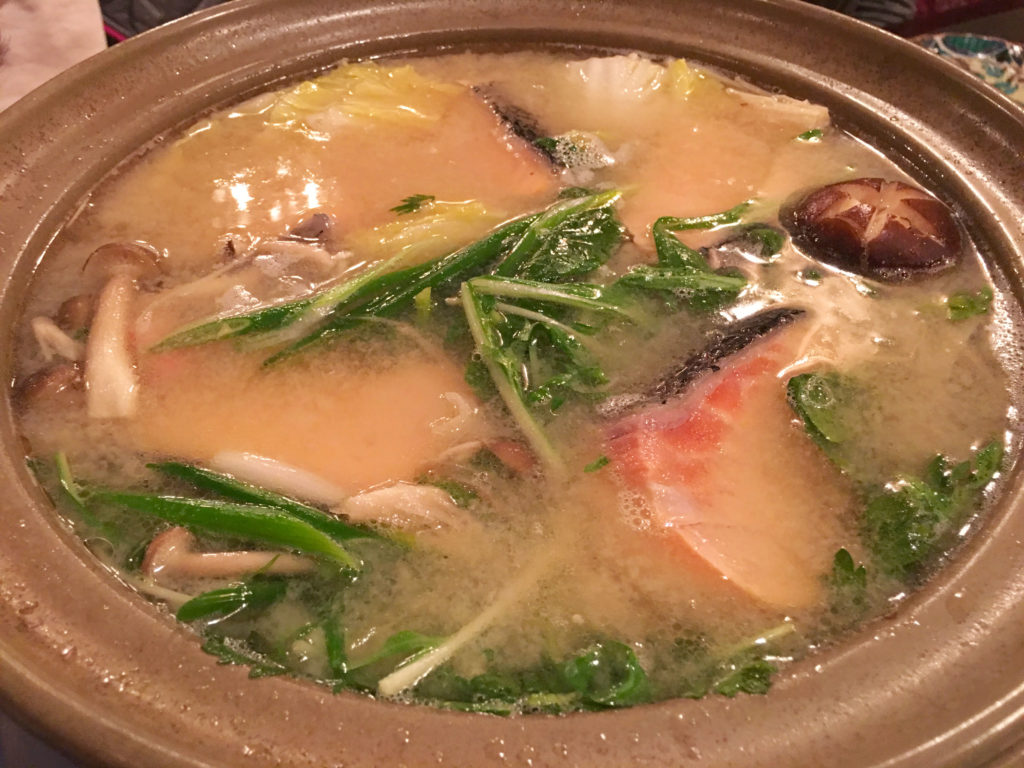 Once the broth boils, one of the staff members will place the vegetables, mushroom, potato noodles, daikon, carrots, and salmon carefully into the pot. You then wait for it again to boil and then it’s ready to eat. Great for a cold New Years Day night. Once you finish the contents, you have the option to add either udon, rice, or ramen. We normally will pair the ishikari broth with ramen due to the richer and heartier flavor. If you choose the addition, they will bring the pot in the back and add some tare to the broth to further season it. However tonight we opted to skip the ramen as we were getting fuller than normal after ordering two osechi boxes.
Once the broth boils, one of the staff members will place the vegetables, mushroom, potato noodles, daikon, carrots, and salmon carefully into the pot. You then wait for it again to boil and then it’s ready to eat. Great for a cold New Years Day night. Once you finish the contents, you have the option to add either udon, rice, or ramen. We normally will pair the ishikari broth with ramen due to the richer and heartier flavor. If you choose the addition, they will bring the pot in the back and add some tare to the broth to further season it. However tonight we opted to skip the ramen as we were getting fuller than normal after ordering two osechi boxes.
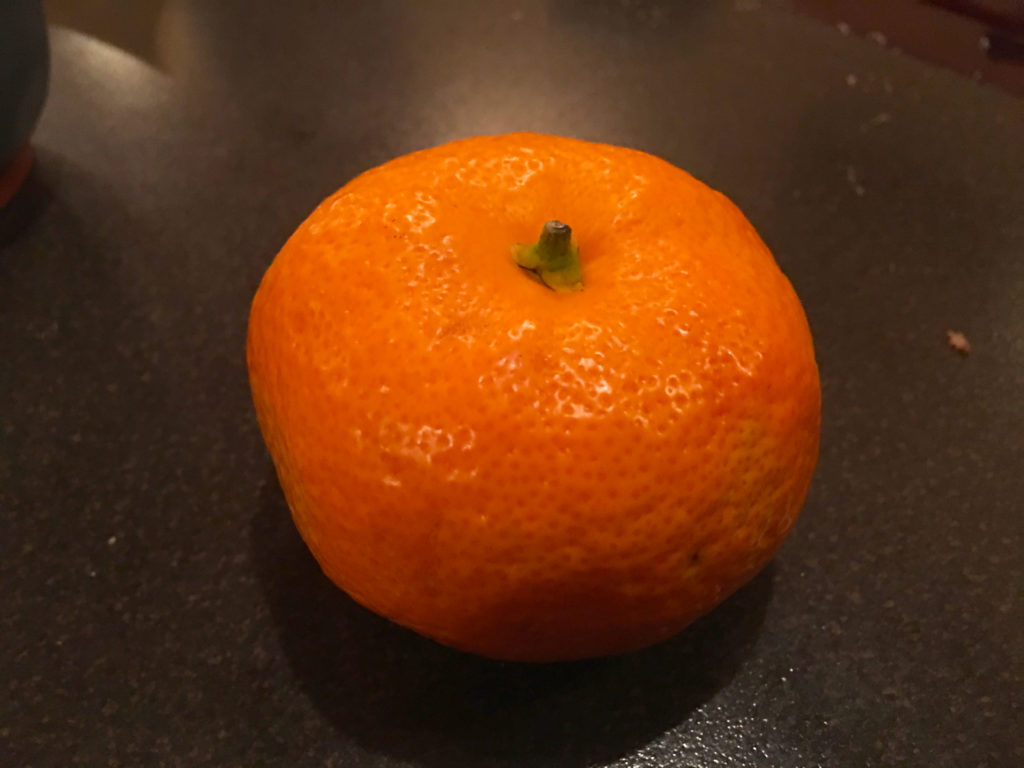 With our meal concluded, we would be handed satsuma or mandarins to wrap up our dinner. This is also something that is part of our New Years tradition we had here. They represent abundance and good fortune.
With our meal concluded, we would be handed satsuma or mandarins to wrap up our dinner. This is also something that is part of our New Years tradition we had here. They represent abundance and good fortune.
Similar to many places in Japan, Kappou Gomi only serves the osechi ryori during New Years Eve and New Years day. They only have two seatings during this period and of course a limited number of osechi box. Make sure to call around October-November to reserve a seating as it’s a small restaurant located in the Richmond district in San Francisco.
